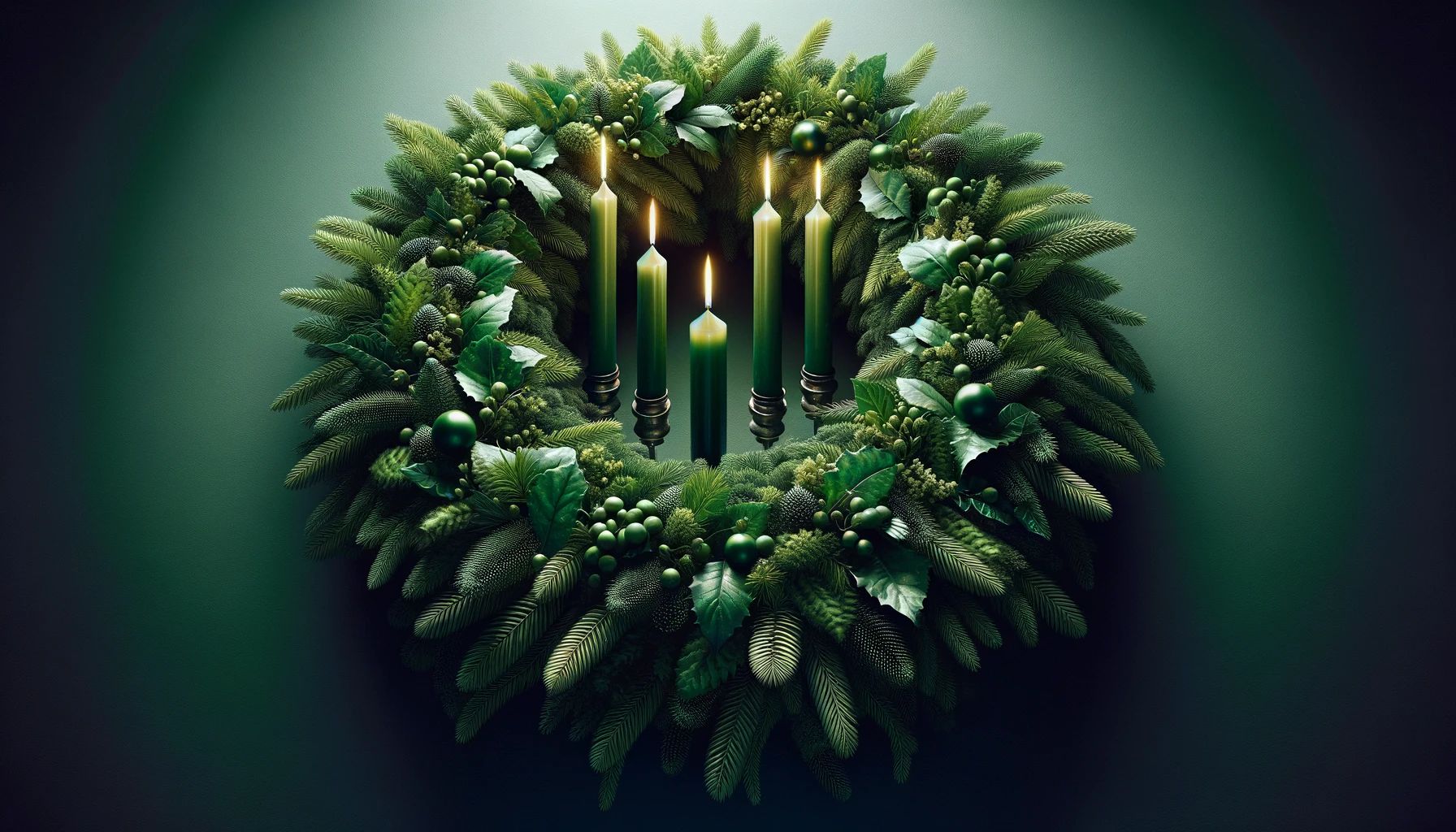Home>Special Themes>How Do You Make An Advent Wreath


Special Themes
How Do You Make An Advent Wreath
Published: February 14, 2024
Peter Smith, Editorial Director at Christian.net, combines deep insights into faith, politics, and culture to lead content creation that resonates widely. Awarded for his contributions to religious discourse, he previously headed a major organization for religious communicators, enhancing dialogue on faith's societal impacts.
Learn how to create a beautiful and meaningful Advent wreath with our special themes guide. Discover the perfect way to celebrate the season.
(Many of the links in this article redirect to a specific reviewed product. Your purchase of these products through affiliate links helps to generate commission for Christian.net, at no extra cost. Learn more)
Table of Contents
Introduction
The Advent wreath is a cherished symbol of the holiday season, evoking a sense of anticipation and hope as it graces homes, churches, and communal spaces. This timeless tradition is deeply rooted in Christian customs, serving as a poignant reminder of the impending arrival of Christmas. Crafted with evergreen foliage and adorned with candles, the Advent wreath holds profound significance, symbolizing the passage of time and the spiritual journey towards the birth of Jesus Christ.
As the days grow shorter and the air becomes crisp, the Advent wreath takes center stage, radiating warmth and illuminating the path towards the joyous celebration of Christmas. Its presence serves as a beacon of light, guiding hearts and minds through the season of Advent, a period of preparation and reflection leading up to the Nativity of Jesus.
The Advent wreath is not merely a decorative ornament; it is a tangible representation of faith, unity, and the enduring spirit of the holiday season. Its timeless beauty and symbolic resonance have made it a beloved tradition in countless households and congregations around the world. As we delve into the history, creation, and significance of the Advent wreath, we embark on a journey that transcends time and space, embracing the rich tapestry of traditions that bind us together in joyous anticipation.
Read more: What Do You Do With An Advent Wreath
History of the Advent Wreath
The origins of the Advent wreath can be traced back to pre-Christian Germanic and Scandinavian cultures, where the use of evergreen wreaths during the winter solstice symbolized life, light, and the enduring cycle of nature. As Christianity spread throughout these regions, the symbolism of the wreath was seamlessly integrated into the observance of Advent, the period of spiritual preparation leading up to Christmas.
The concept of the Advent wreath as we know it today emerged in 16th-century Germany, where both Catholics and Protestants adopted the tradition of lighting candles as a way to mark the four weeks leading up to Christmas. The circular shape of the wreath, representing eternity and the unending love of God, became a central motif, while the evergreen foliage symbolized hope and renewal amidst the winter season.
Over time, the Advent wreath gained widespread popularity across Europe and eventually made its way to North America, where it became an integral part of the Advent traditions in Christian communities. The symbolism of the wreath's four candles, typically three purple and one pink, evolved to represent the themes of hope, love, joy, and peace, corresponding to each week of Advent.
In addition to its religious significance, the Advent wreath also holds cultural and communal importance, fostering a sense of unity and shared anticipation among families and congregations. The act of lighting the candles each week and engaging in prayers or reflections has become a cherished ritual, deepening the spiritual connection to the season of Advent.
Today, the Advent wreath stands as a timeless emblem of faith, resilience, and the enduring light of Christ amidst the darkness of the world. Its rich history and profound symbolism continue to inspire and unite individuals of diverse backgrounds, carrying forward the legacy of hope and anticipation that has defined this beloved tradition for centuries.
Materials Needed
To create an Advent wreath that embodies the timeless symbolism and beauty of this cherished tradition, you will need a few essential materials. These items, when thoughtfully assembled, will culminate in a stunning centerpiece that serves as a visual and spiritual focal point during the Advent season.
1. Wreath Base:
The foundation of the Advent wreath is typically a circular base made of sturdy yet pliable material. Common options include wire frames, grapevine wreaths, or foam rings. The choice of base will depend on personal preference and the desired aesthetic, as each material offers its own unique texture and visual appeal.
2. Evergreen Foliage:
The lush greenery adorning the Advent wreath symbolizes the enduring hope and everlasting life found in Christ. Traditional choices for evergreen foliage include pine, fir, cedar, or holly branches. These natural elements infuse the wreath with a sense of vitality and continuity, serving as a poignant reminder of the eternal love and grace embodied in the Christmas story.
Read more: How To Draw An Advent Wreath
3. Candles:
The centerpiece of the Advent wreath is the set of four candles, each representing a different theme of the season: hope, love, joy, and peace. Three of the candles are typically purple, while the fourth is rose or pink. Additionally, a white candle, known as the Christ candle, may be placed in the center and lit on Christmas Eve or Christmas Day. The candles serve as beacons of light, illuminating the path towards the celebration of Christ's birth.
4. Candle Holders:
Sturdy candle holders or metal clips are essential for securing the candles to the wreath base. These fixtures ensure that the candles remain upright and stable during the Advent season, allowing their warm glow to permeate the surrounding space with a sense of tranquility and reverence.
5. Decorative Accents (Optional):
To personalize the Advent wreath and enhance its visual appeal, consider incorporating decorative accents such as berries, pinecones, ribbons, or dried flowers. These embellishments can add a touch of elegance and individuality to the wreath, reflecting personal style and creative expression.
By gathering these materials and approaching the creation of the Advent wreath with reverence and intention, you can craft a meaningful symbol of faith and anticipation that will enrich your home or communal space throughout the Advent season.
Step-by-Step Instructions
Creating an Advent wreath is a meaningful and contemplative process that invites individuals to engage in a tactile expression of faith and anticipation. Follow these step-by-step instructions to craft a beautiful and symbolic Advent wreath that will serve as a cherished centerpiece throughout the Advent season.
Read more: How Did The Advent Wreath Start
1. Prepare the Wreath Base
Begin by selecting a wreath base that aligns with your aesthetic preferences and complements the intended display location. Whether opting for a wire frame, grapevine wreath, or foam ring, ensure that the base is proportionate to the space it will adorn. Place the wreath base on a flat surface, ready to be adorned with evergreen foliage and candles.
2. Arrange Evergreen Foliage
Gather an assortment of fresh evergreen branches, such as pine, fir, or cedar, and trim them to manageable lengths. Starting from one end of the wreath base, carefully tuck the foliage stems into the frame, securing them with floral wire or hot glue as needed. Continue this process, overlapping the branches to create a lush and visually appealing arrangement that encircles the entire wreath base.
3. Position the Candles
With the evergreen foliage in place, it's time to position the Advent candles. Begin by inserting the candle holders or metal clips into the wreath base at evenly spaced intervals. Then, carefully secure the candles in the holders, ensuring that they stand upright and are positioned securely within the wreath. The three purple candles representing hope, love, and peace, along with the pink candle symbolizing joy, should be evenly distributed around the wreath.
4. Add Decorative Accents (Optional)
For those seeking to add a personalized touch to their Advent wreath, consider incorporating decorative accents such as berries, pinecones, or ribbons. These embellishments can be nestled among the evergreen foliage, adding texture and visual interest to the arrangement. Exercise creativity and discernment in selecting and placing these accents, ensuring that they harmonize with the overall aesthetic of the wreath.
Read more: What Do Advent Wreath Candles Represent
5. Reflect and Pray
As you admire the completed Advent wreath, take a moment to reflect on the profound symbolism it embodies. Consider the themes of hope, love, joy, and peace represented by the candles, and contemplate the spiritual significance of the Advent season. Engage in a prayer or meditation, expressing gratitude for the blessings of the season and the anticipation of Christ's birth.
By following these step-by-step instructions with care and reverence, you will craft an exquisite Advent wreath that radiates the timeless beauty and profound symbolism of this beloved tradition. Displayed prominently in your home or communal space, the wreath will serve as a poignant reminder of the spiritual journey leading up to the joyous celebration of Christmas.
Symbolism of the Advent Wreath
The Advent wreath is steeped in rich symbolism, with each element contributing to a profound narrative of faith, anticipation, and spiritual contemplation. As a visual and tactile representation of the Advent season, the wreath serves as a powerful emblem of the Christian journey towards the celebration of Christ's birth. Understanding the symbolism embedded within the Advent wreath deepens our appreciation for this timeless tradition and invites us to engage with its profound significance.
Evergreen Foliage
The evergreen foliage adorning the Advent wreath holds deep symbolic meaning. In the midst of winter, when nature appears dormant and the landscape is shrouded in cold and darkness, the vibrant greenery of the wreath serves as a poignant reminder of eternal life and the enduring presence of God. The evergreen branches, representing hope and renewal, convey the promise of new beginnings and the unending cycle of life, mirroring the eternal love and grace embodied in the Christmas story.
Circular Shape
The circular form of the Advent wreath holds profound symbolism, representing eternity and the unending nature of God's love. Without a beginning or an end, the circular shape signifies the everlasting nature of divine grace and the timeless presence of Christ in our lives. It serves as a visual reminder of the eternal bond between God and humanity, inviting us to contemplate the enduring faithfulness and unchanging love that define the Christian journey.
Read more: Why Do We Have The Advent Wreath
Advent Candles
The candles adorning the Advent wreath are laden with symbolism, each representing a distinct theme of the season. The first candle, often purple, symbolizes hope, signifying the anticipation of Christ's coming and the promise of salvation. The second purple candle represents love, embodying the boundless love of God manifested in the gift of His Son. The pink candle, lit on the third Sunday of Advent, symbolizes joy, celebrating the imminent arrival of the Savior. The final purple candle signifies peace, evoking a sense of tranquility and the promise of reconciliation through Christ's birth.
Christ Candle
In some traditions, a fifth candle, known as the Christ candle, is placed in the center of the Advent wreath. This white candle is lit on Christmas Eve or Christmas Day, symbolizing the culmination of the Advent journey and the radiant presence of Christ in the world. The illumination of the Christ candle represents the profound joy and spiritual fulfillment found in the birth of Jesus, infusing the Advent wreath with a transcendent sense of hope and salvation.
Collective Reflection
As the Advent wreath is lit each week, the progression of light symbolizes the growing anticipation and spiritual illumination of the season. The act of collectively lighting the candles and engaging in prayers or reflections fosters a sense of communal unity and shared anticipation, inviting individuals to journey together towards the celebration of Christ's birth.
In essence, the Advent wreath encapsulates a tapestry of profound symbolism, weaving together the themes of hope, love, joy, and peace into a visual and spiritual narrative. Its presence serves as a tangible expression of faith and anticipation, inviting individuals to engage in contemplation and reverence as they prepare their hearts for the joyous celebration of Christmas.
Tips for Displaying and Using the Advent Wreath
-
Selecting a Central Location: Choose a prominent and central location for displaying the Advent wreath, such as a dining table, mantlepiece, or communal gathering space. Placing the wreath in a visible and accessible area allows its symbolism to permeate the surroundings, serving as a focal point for reflection and communal engagement.
-
Mindful Candle Lighting: When lighting the candles on the Advent wreath, approach the ritual with mindfulness and reverence. As each candle is lit during the four weeks of Advent, take a moment to reflect on the corresponding theme of hope, love, joy, and peace. Engage in prayers, readings, or quiet contemplation, allowing the warm glow of the candles to evoke a sense of spiritual anticipation and connection.
-
Weekly Rituals: Establish a weekly ritual for lighting the Advent candles, involving family members, friends, or congregants in the ceremonial act. Encourage individuals to take turns lighting the candles and sharing reflections on the significance of the Advent themes. This collective engagement fosters a sense of unity and shared spiritual journey as the season progresses.
-
Incorporating Music and Scripture: Enhance the ambiance surrounding the Advent wreath by incorporating music and scripture readings into the ritual. Select hymns and carols that resonate with the themes of hope, love, joy, and peace, creating a multi-sensory experience that deepens the spiritual impact of the Advent season.
-
Maintaining Fire Safety: Exercise caution when using lit candles in the Advent wreath. Ensure that the wreath is placed on a stable surface and that the candles are positioned securely within the holders. Keep flammable materials away from the wreath, and never leave lit candles unattended. Practicing fire safety measures is essential for a secure and peaceful Advent experience.
-
Personal Reflection Time: Encourage individuals to spend quiet moments in the presence of the Advent wreath, engaging in personal reflection and meditation. The wreath's symbolism and gentle illumination provide an ideal backdrop for introspection, allowing individuals to connect with the deeper spiritual significance of the season.
-
Advent Wreath Blessing: Consider arranging for a formal blessing of the Advent wreath, either within a religious service or as a standalone ceremony. The blessing serves as a poignant affirmation of the wreath's significance and invites divine grace to infuse the Advent season with profound meaning and spiritual enrichment.
By incorporating these tips into the display and use of the Advent wreath, individuals and communities can deepen their engagement with this cherished tradition, fostering a sense of spiritual connection and anticipation as they journey towards the celebration of Christmas.
Conclusion
In conclusion, the Advent wreath stands as a timeless symbol of faith, hope, and anticipation, weaving together centuries of tradition and profound symbolism into a tangible expression of the Advent season. As we reflect on the history, creation, and significance of the Advent wreath, we are reminded of the enduring power of this cherished tradition to unite hearts and minds in joyful anticipation of Christmas.
The rich history of the Advent wreath, rooted in ancient customs and Christian observance, serves as a testament to the enduring resonance of its symbolism. From its origins in pre-Christian Germanic and Scandinavian cultures to its integration into the Advent traditions of Christian communities worldwide, the wreath has transcended time and cultural boundaries, embodying the universal themes of hope, love, joy, and peace.
Crafting an Advent wreath involves a thoughtful and intentional process, as each element – from the evergreen foliage to the symbolic candles – carries profound meaning. The circular form of the wreath, representing eternity and the unending love of God, serves as a visual reminder of the timeless nature of faith and grace. The illumination of the Advent candles, each embodying a distinct theme of the season, invites us to engage in collective reflection and spiritual contemplation as we journey towards the celebration of Christ's birth.
Displaying and using the Advent wreath is not merely a decorative practice; it is a communal and spiritual engagement that fosters unity and anticipation. From mindful candle lighting rituals to incorporating music and scripture, the Advent wreath becomes a focal point for shared reflection and reverence, enriching the Advent experience for individuals and communities alike.
As the warm glow of the Advent candles illuminates our homes and communal spaces, it serves as a beacon of hope and a reminder of the transformative power of the Christmas story. The Advent wreath invites us to pause, reflect, and prepare our hearts for the joyous celebration of Christ's birth, infusing the season with a sense of spiritual depth and anticipation.
In essence, the Advent wreath transcends its physical form, becoming a tangible representation of the enduring light of Christ amidst the darkness of the world. Its presence serves as a reminder of the timeless message of love, hope, and renewal, inviting us to embrace the true spirit of the Advent season as we eagerly await the arrival of Christmas.










